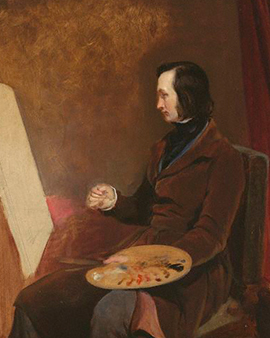


John Phillip was a Scottish painter of the Victorian age, who, despite his origins, became known primarily for his depictions of the Spanish way of life.
Phillip came from a poor background, only with the economic help of Baron Panmure, who recognized his artistic talent, was he able to take lessons in London from the British portrait painter Thomas Musgrave Joy and later study at the Royal Academy of Arts. Here he met the painter Richard Dadd and became, together with William Hogarth, David Wilkie and others, part of his artist association "The Clique", which was dedicated to academic painting. Like Wilkie, Phillip began painting Scottish peasants and religious families at the beginning of his career. When he moved to Seville in Spain for health reasons, the impressions overwhelmed him and he began to paint scenes and themes typical of Spain - street scenes like bullfights. The Spanish artists Diego Velázquez and Bartolomé Esteban Murillo served as his special inspiration. Thus in 1854 he created "A Letter Writer, Seville", a work that was strongly reminiscent of the group of artists of the Pre-Raphaelites and thus stood in contrast to the attitudes of the "clique". Phillip's inspiration was so great that he encouraged his artist colleagues to travel to Spain, and the portrait and history painter Edwin Long followed his example. Phillips himself travelled to the Iberian Peninsula in 1851, 1856 and 1860. Phillips' style expanded after each trip to Spain and became more picturesque, he created the works "The Early Career of Murillo" and "La Gloria", which shows a Spanish wake. "The early career of Murillo" was auctioned in 2003 for over 150.000 USD. Phillip was also commissioned to portray the wedding of the German Emperor Frederick III and his wife Victoria. In general, the Spanish royal family is said to have been very fond of Phillip, so that the members often gave each other paintings by the artist as Christmas gifts. In 1866 he left London for the last time, in Rome and Florence he studied the master of the Italian High Renaissance Titian.
Phillip was married to Richard Dadd's sister who, like the brother, was struggling with mental illness in old age. Phillip himself died by a stroke in 1867 when he wanted to visit his friend and painter William Powell Frith. Today, one finds many of his works in museums, the National Gallery in London, the National Gallery of Scotland and the Museo del Prado in Madrid. The self-portrait "The Evil Eye" (1859) is in the art centre Hospitalfield House, together with other portraits of the "clique". Because of his love for Spain he is often called "Spanish Phillip".

John Phillip was a Scottish painter of the Victorian age, who, despite his origins, became known primarily for his depictions of the Spanish way of life.
Phillip came from a poor background, only with the economic help of Baron Panmure, who recognized his artistic talent, was he able to take lessons in London from the British portrait painter Thomas Musgrave Joy and later study at the Royal Academy of Arts. Here he met the painter Richard Dadd and became, together with William Hogarth, David Wilkie and others, part of his artist association "The Clique", which was dedicated to academic painting. Like Wilkie, Phillip began painting Scottish peasants and religious families at the beginning of his career. When he moved to Seville in Spain for health reasons, the impressions overwhelmed him and he began to paint scenes and themes typical of Spain - street scenes like bullfights. The Spanish artists Diego Velázquez and Bartolomé Esteban Murillo served as his special inspiration. Thus in 1854 he created "A Letter Writer, Seville", a work that was strongly reminiscent of the group of artists of the Pre-Raphaelites and thus stood in contrast to the attitudes of the "clique". Phillip's inspiration was so great that he encouraged his artist colleagues to travel to Spain, and the portrait and history painter Edwin Long followed his example. Phillips himself travelled to the Iberian Peninsula in 1851, 1856 and 1860. Phillips' style expanded after each trip to Spain and became more picturesque, he created the works "The Early Career of Murillo" and "La Gloria", which shows a Spanish wake. "The early career of Murillo" was auctioned in 2003 for over 150.000 USD. Phillip was also commissioned to portray the wedding of the German Emperor Frederick III and his wife Victoria. In general, the Spanish royal family is said to have been very fond of Phillip, so that the members often gave each other paintings by the artist as Christmas gifts. In 1866 he left London for the last time, in Rome and Florence he studied the master of the Italian High Renaissance Titian.
Phillip was married to Richard Dadd's sister who, like the brother, was struggling with mental illness in old age. Phillip himself died by a stroke in 1867 when he wanted to visit his friend and painter William Powell Frith. Today, one finds many of his works in museums, the National Gallery in London, the National Gallery of Scotland and the Museo del Prado in Madrid. The self-portrait "The Evil Eye" (1859) is in the art centre Hospitalfield House, together with other portraits of the "clique". Because of his love for Spain he is often called "Spanish Phillip".
Page 1 / 1






